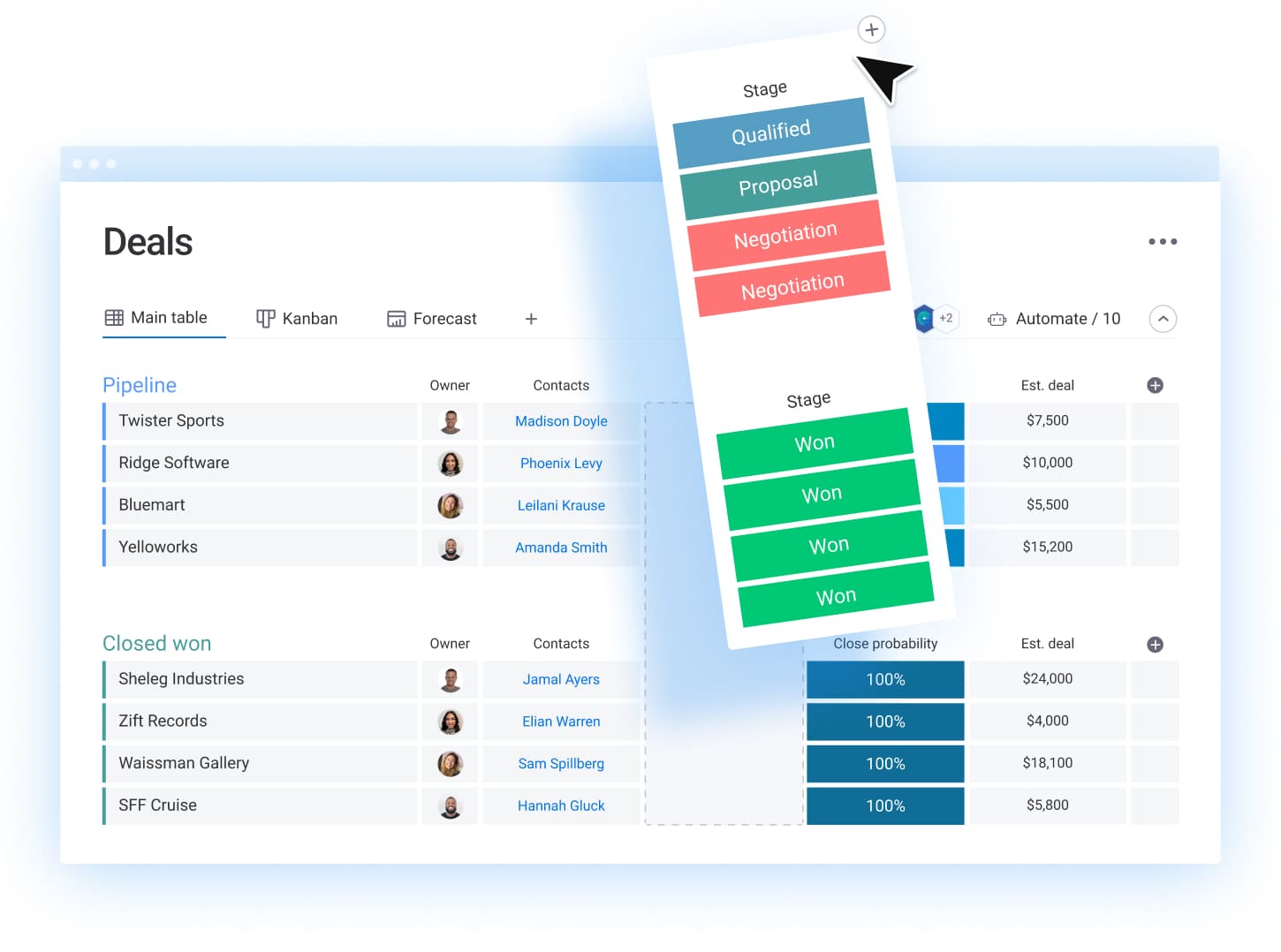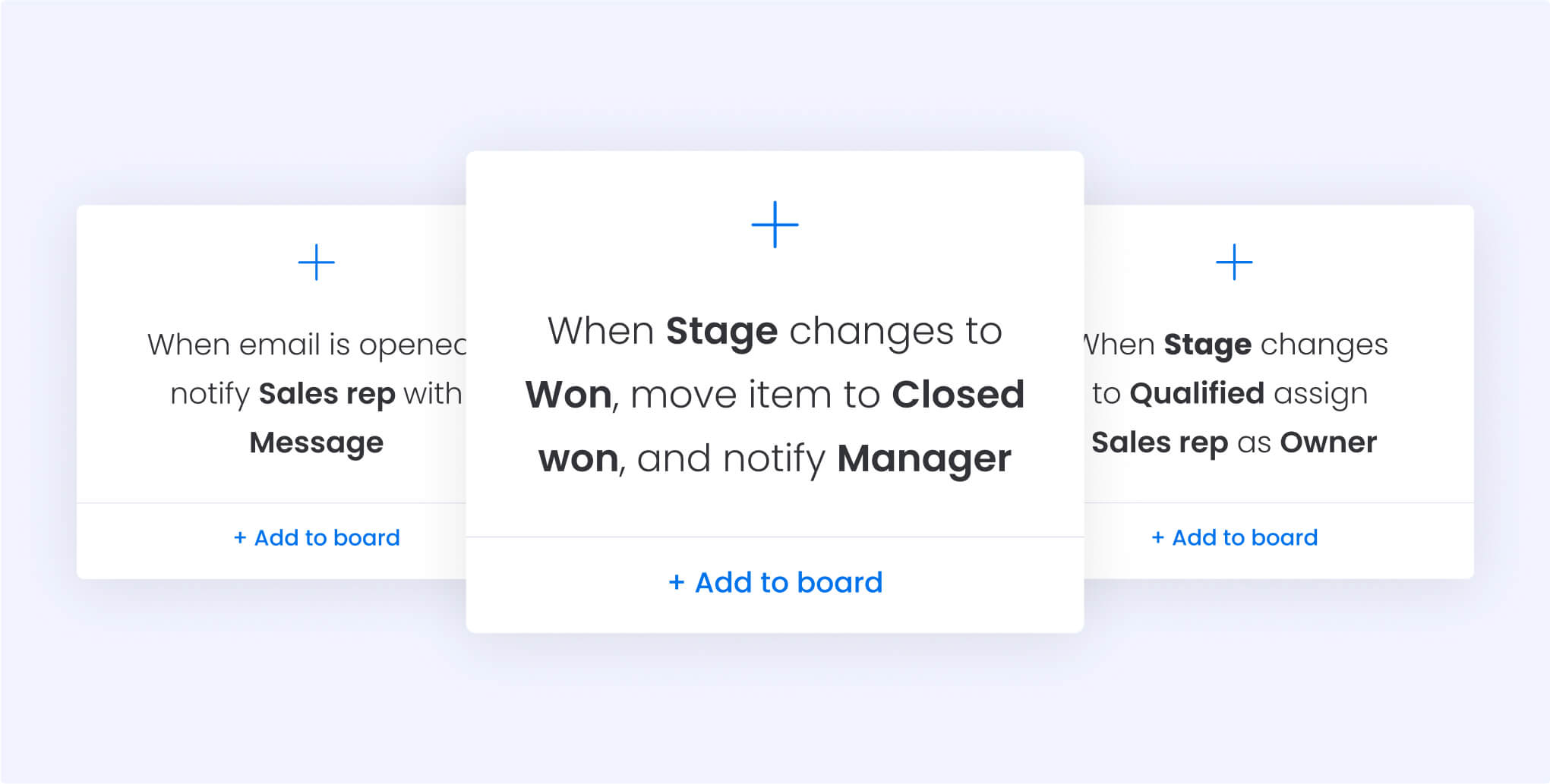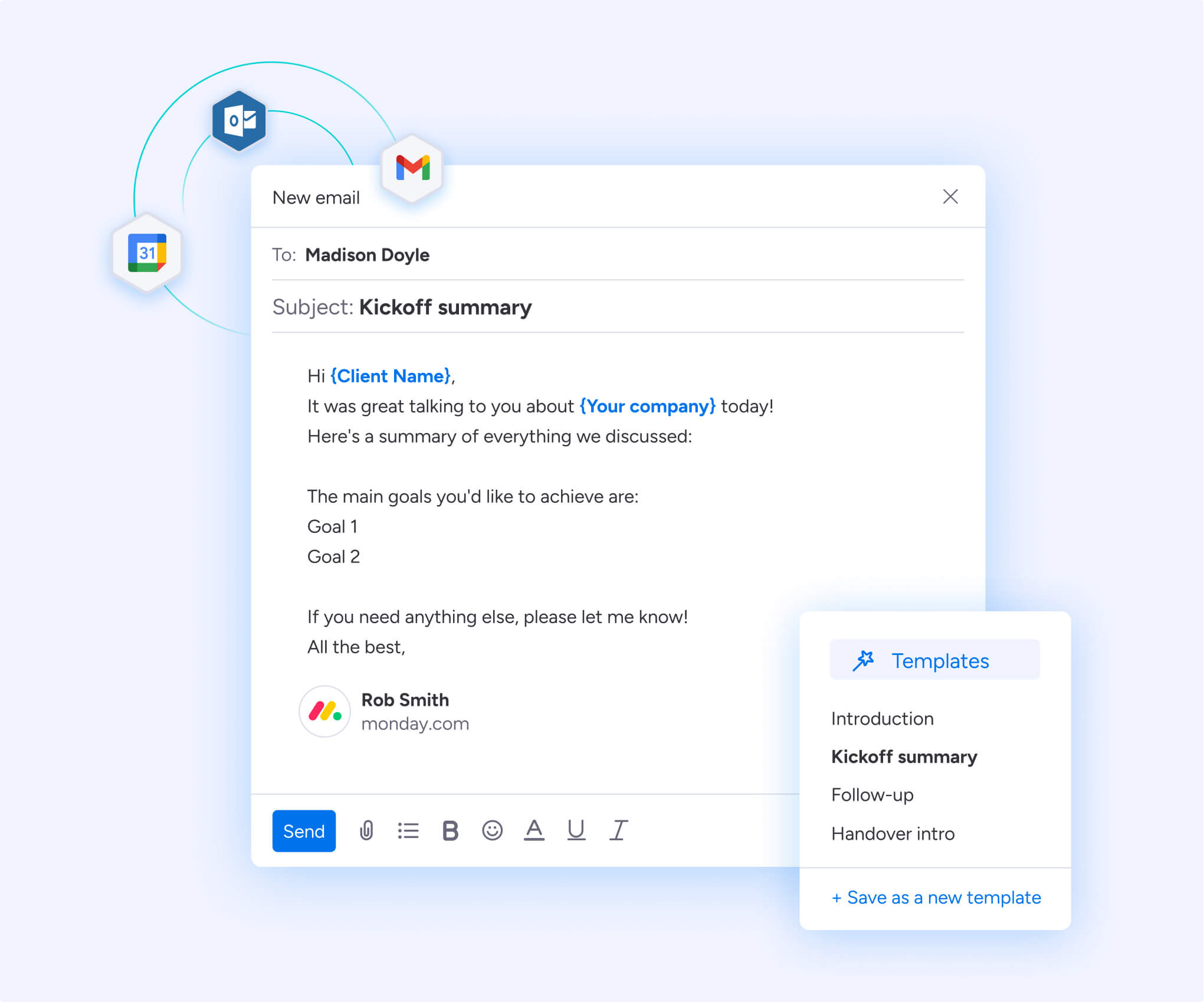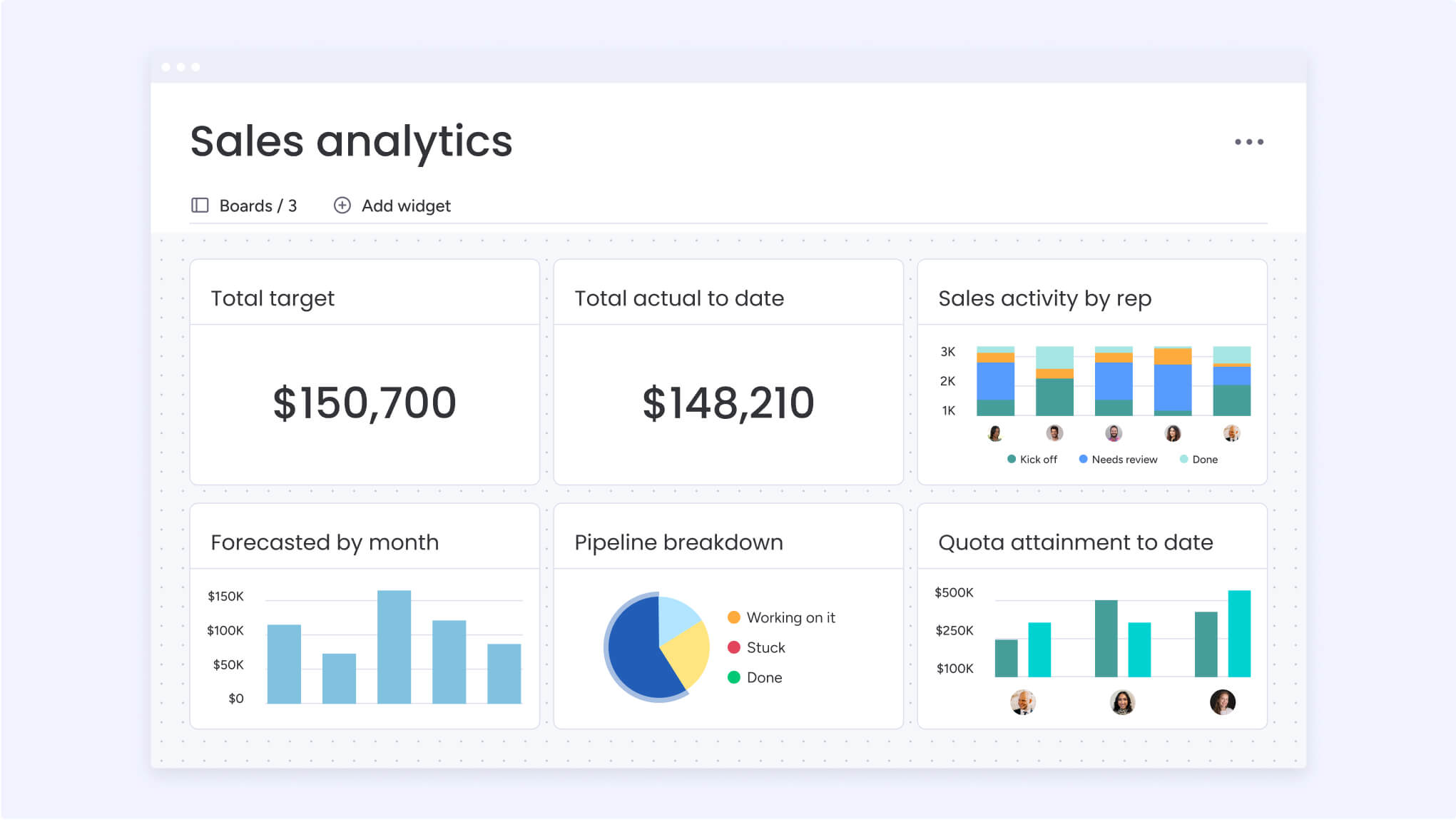Nailing your company’s B2B sales process is one of the most important ways to increase sales. Think of your sales process like a map. It’s there to guide your sales team through the intricacies of selling to other businesses.
Aside from a solid B2B sales process, it’s also essential to have the right tools to make selling quicker and easier. Artificial intelligence (AI) is helping sales teams boost revenues while saving time and improving customer satisfaction.
This blog post will guide you through B2B sales processes, including how they differ from B2C sales, AI B2B sales tools to consider using, and how AI-powered platforms like monday CRM provide a well-rounded solution for maximizing B2B sales.
Try monday CRMWhat is B2B sales?
B2B sales involve one business selling products or services to another business.
Instead of an individual, the customer in B2B sales is usually a company or organization, which can make the sales process more intricate.
Typically, B2B sales involve a lot more touchpoints throughout the sales process, such as demos, presentations, negotiations, changes to the deal, and discussions with those making purchasing decisions. All of this extends the sales cycle in B2B sales, making it a longer process than selling to customers with B2C sales.
What is the B2B sales process?
B2B sales processes can look different from one business to another. Sales teams will build a process that works for them and their customers, including generating sales leads, nurturing them, following up, and closing deals. B2B sales processes can also include post-sales actions and service.
The length of a sales cycle varies according to the method of approach, individual B2B buyers, and contract value. Some sales cycles can take a few days to close, while others can take months. Furthermore, the length of your sales cycle can depend on your industry, with B2B software sales taking an average of three months and other industries like construction, pharmaceuticals, and energy taking closer to five.
B2B sales funnel
Sales teams need to clearly define their sales cycle to build consistency among B2B sales reps, establish transparency, and create predictable systems that generate better ROI. A good way to build out unique B2B sales cycles and processes is by looking at a typical B2B sales funnel, which includes six core stages:
- Awareness: Prospective customers discover your company through marketing, ads, or referrals
- Interest: They engage with your content to learn more about your offering
- Consideration: Leads consider options, reviews, and request demos or consultations
- Intent: Prospects show buying intent by requesting quotes or evaluating features
- Purchase: They finalize the deal, sign contracts, and complete the transaction
- Loyalty: Your business retains customers with support and ongoing engagement
B2B lead generation processes
Leads can come from a wide range of sources. When it comes to building a reliable B2B sales process, it’s important to account for two types of lead management: outbound and inbound.
For outbound sales processes, sales reps actively search for ideal B2B customers, launch outreach efforts, and drive sales. This involves setting up initial contact with prospects, pitching them, and responding to their needs and questions.
Inbound sales processes look a little different. A potential customer will find your company after understanding they have a problem that needs a solution. B2B sales processes for inbound sales involve confirming what solution the customer needs and providing social proof through reviews and case studies to emphasize that your business can offer the right solution.
For both cases, it’s essential for businesses to speed up sales processes, whether outbound or inbound, and continuously nurture leads through intentional and personalized engagement. A good way to do this is by creating a B2B sales leads database through a platform like monday CRM, where you can use automations and AI features to engage leads with tailored content.
Try monday CRMB2B vs. B2C sales: What's the difference?
B2C is a business model where businesses sell products directly to individual consumers. Both B2B and B2C companies follow a set process to connect with prospective clients, however, they involve different approaches. Below, we’ll break down the key differences between B2B and B2C sales cycles.
| B2B sales | B2C sales | |
|---|---|---|
| Customers | Businesses, organizations, or professionals | Individual consumers |
| Sales strategies | Relationship-based, personalized approach | Mass marketing, impulse-driven |
| Sales cycle | Longer, involves multiple decision-makers | Shorter, often a single decision-maker |
| Marketing | Focuses on education, ROI, and logical benefits | Emotion-driven, highlighting lifestyle appeal |
| Lead generation | Targeted prospecting, referrals, networking | Wide-reaching through ads, social media platforms |
| Decision-making | Rational, data-driven, ROI-focused | Emotional, convenience, and price-driven |
| Stakeholders | Multiple (executives, procurement, finance) | Usually one (the potential buyers themselves) |
| Pricing | Negotiable, customized per client | Fixed, standardized pricing |
| Customer relationship | Long-term partnerships, ongoing support | One-time or repeat purchases, less interaction |
| Product complexity | More complex, requires demos or customization | Simpler, ready-to-use products |
8 stages of the B2B sales process

Generally, most B2B sales processes will follow a similar trajectory, though they can differ from one business to another. These eight B2B sales stages mark the journey B2B sales teams go through from acquiring leads to closing a deal.
1. Prospecting
First, you need to identify potential customers who might be a good fit for your solution. This can be done through inbound or outbound leads and involves researching industries and markets, leveraging channels like LinkedIn, going to networking events, or using AI tools to find promising leads.
2. Assessment
Once you have leads, it’s time to dig deeper and assess their needs, challenges, and whether your solution is a good match. This stage often involves discovery cold calling or introductory emails to gather information and determine if there’s a real opportunity.
3. Qualification
Not every lead is worth pursuing, so this stage is about narrowing down the list to those who are genuinely interested and have the budget, authority, and need to buy. Many sales teams use frameworks like BANT (Budget, Authority, Need, Timing) to qualify leads.
4. Pitch
Next, you need to present your solution, whether through a product demo, sales pitch deck, or customized proposal. A great pitch focuses on how your product solves a client’s specific pain points rather than just listing features.
5. Objections
It’s normal for clients to raise objections, whether it’s pricing concerns, competition, or internal roadblocks. This is your chance to address doubts, clarify value, and reassure prospects that your solution is the right choice.
6. Closing
After answering any questions and smoothing out objections, it’s time to finalize the deal. This stage often involves negotiation, handling multiple stakeholders, sending contracts, and confirming payment terms. A smooth closing procedure makes it easy for the customer to say yes.
7. Follow-up
Closing a deal might mark the end of a sales process, but it’s just the beginning of a relationship. Send a timely follow-up to ensure a smooth onboarding experience, address any lingering questions, and set the stage for long-term customer satisfaction.
8. Check-in
Even longer after a sale closes, make a habit of checking in to continue building customer loyalty. Regular touchpoints, email marketing, updates, and support show that you’re invested in their success, which can lead to upsells, renewals, or referrals.
Close more deals with AI B2B sales tools
Making use of technology can help you speed up your sales efforts and make your life easier as a sales professional. However, with so many tools out there, it can be tricky to know which ones will really make a difference and not just clutter up your workflows.
Some sales tools you might want to consider include customer relationship management (CRM) software to help you manage leads, contacts, and resources for building effective sales and content marketing processes and assets. It’s also important to have performance management tools to track sales velocity and communication platforms to facilitate outreach.

Aside from these tools, AI is making it easier for teams to enhance B2B business operations without scaling their budgets or resources. Despite its advantages, sales teams are still hesitant to adopt AI tools. According to monday.com’s World of Work Report,
Only about half (51%) of sales teams are currently using AI tools, meaning half of sales teams risk falling behind their competitors.
AI-powered tools are quickly becoming critical to B2B sales, offering insights, time-saving opportunities, and better personalization. McKinsey analyzed 16 business functions, and among them, four accounted for 75% of generative AI’s trillion-dollar value, among them sales and marketing. Here are just a few of the ways AI B2B sales tools can bring more value to your business:
- Sales forecasting tool: Use AI to accurately predict future sales growth based on potential leads and deals in the pipeline
- Workflow automation: Automate repetitive tasks like data entry, follow-ups, and lead scoring to improve efficiency
- Personalization: Leverage AI to tailor outreach, emails, and content based on customer behavior and preferences
- Lead scoring: AI ranks leads based on engagement, likelihood to convert, and past interactions to prioritize outreach
- Chatbots and virtual assistants: Automate customer interactions, answer inquiries, and qualify leads in real time
- Sales analytics: AI-driven insights help analyze sales trends, optimize strategies, and refine decision-making
Oftentimes, one platform, like a CRM, combines all the tools mentioned above along with other features, giving sales teams an end-to-end solution for sales enablement. For example, monday CRM allows teams to manage all stages of the buyer journey, unite sales communication, manage contacts, and leverage AI to improve sales strategies. Additionally, it’s easy to integrate external tools so that your team can sync data and workflows on a single platform.
Try monday CRMStrategies and best practices to win the B2B sales process
Often, it takes a lot of trial and error to understand what works and what doesn’t for your clients. That said, there are still some tried-and-true best practices B2B sales professionals can use to improve B2B sales techniques.
Get to know your customer
Clearly define your ideal customer and ensure everyone on your sales team is aware. It’s important to understand their key pain points and goals to correctly position your product as the right solution.
Keep your leads engaged at all times
Ideally, you want to acquire warm leads through inbound marketing. However, not every lead is going to come in warm. Even for cold leads, it’s important to periodically engage them with personalized messages, check-ins, and updates on your product or service.
Highlight solutions over products
When pitching your product or service to potential clients, don’t waste time talking endlessly about your offer. Instead, address how your product or service is the solution to their pain points, using demos, case studies, and testimonials to establish social proof.
Build relationships with the right prospects
Not every prospect is the right prospect. It’s important to hone in on the most likely decision-makers and continuously nurture them. You can also consider target-account based selling (TAS) for a more well-rounded approach.
Leverage automation for quicker conversions
Automate manual and repetitive tasks so that your sales team can focus more of their time on building relationships with leads and clients. Automations can help you keep leads in the pipeline engaged with regular communication and can also cut down on time spent on internal workflows with instant notifications to relevant stakeholders.
Use analytics to revisit your sales strategies
Constantly analyze your sales processes based on customer feedback and data. By collecting this information, you can reassess if your current sales strategies are the best ones to help you meet your sales targets. Use data and feedback to make regular updates to your strategies for better results.
How to build a custom sales process in minutes with monday CRM
There are many factors, actors, and complexities to be considered in the B2B sales process that rewards a consultative, collaborative approach. There’s no one-size-fits-all solution or process that works in every organization. However, with a customizable platform like monday CRM, you can create a tailored solution that supports your team’s B2B strategies.
monday CRM delivers on value by streamlining the selling process across all departments for heightened productivity. With monday CRM, teams can close deals sooner while improving sales processes across the board. Thanks to its built-in AI features, monday CRM makes it easy for teams to use data and automations to inform decisions, personalize communications, and prioritize important leads.
Let’s drill down into more monday CRM features that make it a great B2B sales platform.
Automate workflows with AI

There are a lot of moving parts in B2B sales, and automations helps teams make sure nothing falls through the cracks. In monday CRM, AI-led automation can help score and assign leads to the right sales team, send follow-ups and reminders to clients, and provide status updates to stakeholders so everyone is on top of the current deals.
Generate personalized sales content

Personalization is key, but tailoring every message to each lead and client is time-consuming. monday CRM’s AI can compose personalized messages based on historical data and previous interactions so that sales teams can make sure every communication lands where it’s supposed to.
Instantly prioritize incoming leads

Let AI sort through incoming leads by scoring and prioritizing them according to the parameters you set. This way, sales reps can focus their energy on the leads most likely to convert while monday CRM’s AI does all the background work on accurately qualifying them.
Get real-time AI-powered sales insights

monday CRM offers real-time AI-powered insights, reports, and sales dashboards so that sales managers can keep track of team sales performance and deals in the pipeline. Additionally, with monday CRM’s sales forecasts, sales leaders can view whether actual sales are meeting targets and use real data to adjust sales strategies to reach goals.
Learn more about other types of sales: Direct Sales, Inside Sales, SaaS Sales, AI Sales
Try monday CRMImprove your B2B sales process with the right platform
B2B sales processes help sales teams stay on the right track and handle every lead and customer the same way. When paired with AI tools and best practices, B2B sales don’t have to be complicated. Even though selling to other businesses can be a complex and drawn-out process, platforms like monday CRM help simplify the entire sales cycle so that B2B companies can close more deals in less time and have more happy customers.
FAQs
What is B2B sales outsourcing?
B2B sales outsourcing is when a company hires an external agency or team to handle part or all of its sales process, such as lead generation, prospecting, or closing deals. This helps businesses scale faster, reduce costs, and focus on core operations.
What are the key B2B sales pipeline stages?
The key stages of a B2B sales pipeline typically include prospecting, lead qualification, initial contact, analysis, proposal, negotiation, and closing the deal. Some pipelines also include post-sales engagement and retention.
What is the B2B sales cycle?
The B2B sales cycle refers to the process that businesses follow to sell products or services to other companies, from lead generation to closing the deal. It tends to be longer and more complex than B2C sales, involving multiple decision-makers and a consultative approach.
How can you increase B2B sales?
There are different strategies you can follow to increase B2B sales. All these revolve around acquiring better leads. Once you define your ideal prospect, make a list of companies that would benefit from your product and then align sales and marketing teams to seek out high-quality leads and invest in inbound lead generation.
What is an example of B2B sales?
The most common examples of B2B sales are companies that provide software services (B2B SaaS). One company will sell their software, such as a CRM, to another company that’s going to use it to track and generate more leads and sell their products.
 Get started
Get started 
